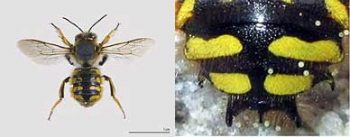By Vidya Rajan, Columnist, The Times
 Human behavior is not completely governed by biological sex. People experience a remarkable natural degree of behavioral freedom which, however, is held in check by the expectations of society. Without comparable societal structures, to what degree do other animal species experience sex-based roles? Are sex-based roles in nature invariable, interchangeable, or nonexistent?
Human behavior is not completely governed by biological sex. People experience a remarkable natural degree of behavioral freedom which, however, is held in check by the expectations of society. Without comparable societal structures, to what degree do other animal species experience sex-based roles? Are sex-based roles in nature invariable, interchangeable, or nonexistent?
To explore the influence of sex on the behavior of animals, we need to first define sex. A simple definition is that females produce eggs – the larger of the two gametes; the other is sperm produced by males. Many animals produce both eggs and sperm; worms, snails, several fish and many plants’ flowers have both male and female parts. I have written on this previously [1]. For example, mangrove killifish and starfish that have both sexual appendages simultaneously, and hamlets are a tropical fish that can even alternate sexual identities if they find a partner over a series of sequential matings [2]. Another type of hermaphroditism is called dichogamy. In this mechanism, an individual can change their sex during their lifetime in response to environmental pressures. Sequential hermaphrodites can be protandrous: initially male, and then change to female, such as in clownfish. Alternately they can be protogynous: initially female, and then change to male, such as wrasses [3]. Then there is the case of the Lythrypnus dalli, a coral reef fish. When dominant, it changes its sex to male, but when submissive, to female. Back and forth its sex changes, depending on who is around, and how macho the others are [4].
So how does machismo occur? Testosterone, the male sex hormone, promotes muscle growth and, therefore, strength. Although testosterone in humans has been shown to be associated with aggressiveness under limited parameters such as social dominance or low self-esteem [5]. In many animals, the males fight for the chance to mate with a female, an evolutionary process known as sexual selection. Curiously, the relationship between physical domination and masculinity is also seen in hyenas, where the pack leader is a female. These dominant females are the only sexually active females in the group, but in their external appearance they may be mistaken for males because they actually grow apparent male external genitalia due to increased amounts of testosterone. Female chinchillas and older female elephants are also more socially dominant, although in the case of the elephant matriarchs, this dominance is attributed to accumulated knowledge of food and water sources in the environment, and they do not have external male genitalia.
In humans, gender-based roles are fueled by norms which vary widely and situationally. To take an unusual example, warrior women who defend their society with taking to arms are thought to be precipitated by three potential scenarios [6]: 1. Societal acceptance of women’s warlike potential; 2. Specific combat roles for women; and 3. Dire need or exceptional circumstance for everyone to participate in war. Stepping lightly over the first two cases which mostly involve specific societal and cultural norms, dire need is clearly a precipitating factor in all animals in all situations. There are octopus moms who starve to death protecting the eggs they lay to hippo moms who will make short work of anyone, even Nile crocodiles, who threaten their babies. These fiercely protective maternal instincts have entered the lexicon as “mama bears”. But it’s not just one mom that may be protective, sometimes there are thousands of angry “sister mom” respondents to a disturbance that threatens the peace. Meet the social insects.
Social insects of the Order Hymenoptera, such as honeybees, wasps, and ants, will swarm an invader, biting and stinging to protect the hive and its occupants. As everyone knows, the single most important individual in these colonies is the queen. Her genetics informs the hive’s character, including mite resistance, aggressiveness, foraging strength, and overwintering success. The workers in a hive are sterile females, not only supplying the hive but also protecting it using their jaws or abdomen-mounted stinger. In social bees, this organ is derived from the ovipositor, a tube through which eggs are laid. Males lacking the ovipositor lack therefore lack the stinger. But that should not preclude drones from developing other defense apparatus such as massive jaws, such as those of termites and ants. The answer probably lies in the proportion of female workers to drones in a colony, and the role that drones play in mating with a fast-moving queen.
Haplodiploidy, the process by which the queen can lay fertilized eggs which develop into diploid females or unfertilized eggs which develop into haploid males, allows the colony to manage the sex ratio and therefore make more of the “more helpful sex”, the females. If females are also overrepresented in the population, the reproductive value of each individual is lowered, providing a feedback loop where it is more beneficial to make more females [7]. Over evolutionary time, this developed into the eusociality with extreme altruism that we see with honeybees and wasps.
Given this extreme cooperation, how to explain the relative defenselessness of drones? Despite their size and musculature, drones lack stingers or even large jaws to defend the queen. The answer may lie in their extreme specialization for mating. The drone is specialized to mate with a fast-moving honeybee queen in flight. Thus, drones have massive eyes with which to see her, and presumably chemical receptors to track her presence. But the presence also of jaws of a size that befits a defender would be a severe drag on the drone’s flying ability due to its weight and drag. Presumably, lighter drones maneuver better in flight, with the larger drone size being a minimum value for the size of the spermatheca that contain the sperm for the queen to keep laying workers: too few sperm, and the colony dies out.
But lest you develop a blanket contempt for male bees in the defense realm, take a gander at the imposing spines of the European wool carder bee (Anthidium manicatum). The male bee occupies a unique role: tending a harem of females who strip the fuzz off leaves (hence the name carder) to line their nests. Unlike other drones, this male protects his flowering patch – a phenomenon known as resource defense – chasing off interlopers such as other bees from his patch with large mandibles and medieval looking defensive spines on his rear. These bees were introduced to the United States in the 1960s and are now distributed widely. If you have a nice patch of flowers and see a wasp-colored, fat, half-inch bee vigorously defending the area, you are observing this atypical drone in action.

Figure: European wool carder bee males showing whole bee (left) and spines on rear end (right). Produced under CC BY-SA 3.0 license. Left image: No machine-readable author provided. Soebe assumed (based on copyright claims) Right image: Didier Descouens. Reproduced from: https://commons.wikimedia.org/w/index.php?curid=276037
It appears that, in animal societies, roles of mother, protector, and resource gatherer are interchangeable in many cases. Given these biological phenomena, the idea that human roles are purely sex-driven seems divorced from reality.
- Rajan, V. Inner Nature: Gender – Sex Made Visible | The Unionville Times. 2021.
- Erisman BE, C.M., Hastings PA, A Phylogenetic Test of the Size‐Advantage Model: Evolutionary Changes in Mating Behavior Influence the Loss of Sex Change in a Fish Lineage. The American Naturalist, 2015. 174(3).
- Benvenuto, C., et al., Ecological and evolutionary consequences of alternative sex-change pathways in fish. Scientific Reports, 2017. 7(1): p. 1-12.
- Lorenzi V, C.R., Summers CH, Earley RL, Grober MS, Serotonin, social status and sex change in the bluebanded goby, Lythrypnus dalli. Physiology and Behavior, 2009. 97(3-4).
- Coccaro, E.F., Testosterone and Aggression: More Than JustBiology? Biological Psychiatry, 2017. 82: p. 234.
- Streatfield, S., Women in Combat: A Historical Perspective, in Phi Alpha Theta Upper New York Regional Conference. 2014.
- Gardner, A.a.R., L., Haplodiploidy, Sex-Ratio Adjustment and Eusociality. American Naturalist, 2013. 181: p. E60-E67.




